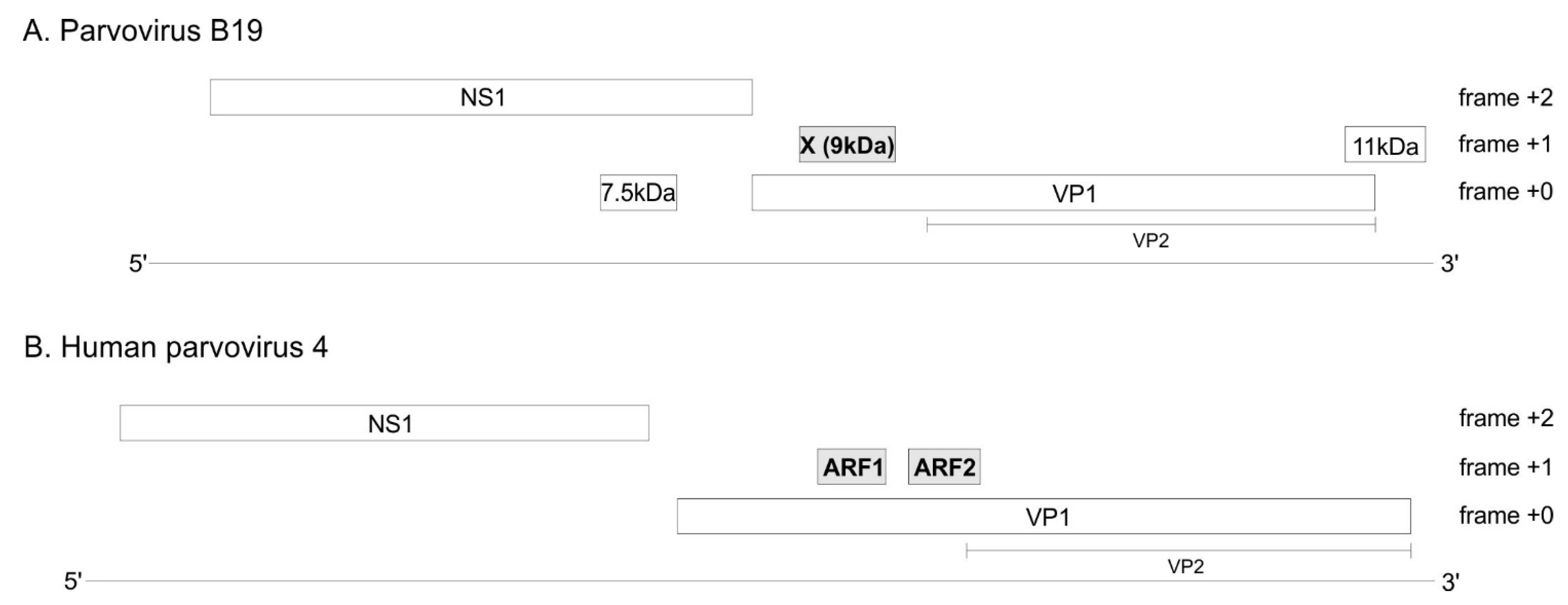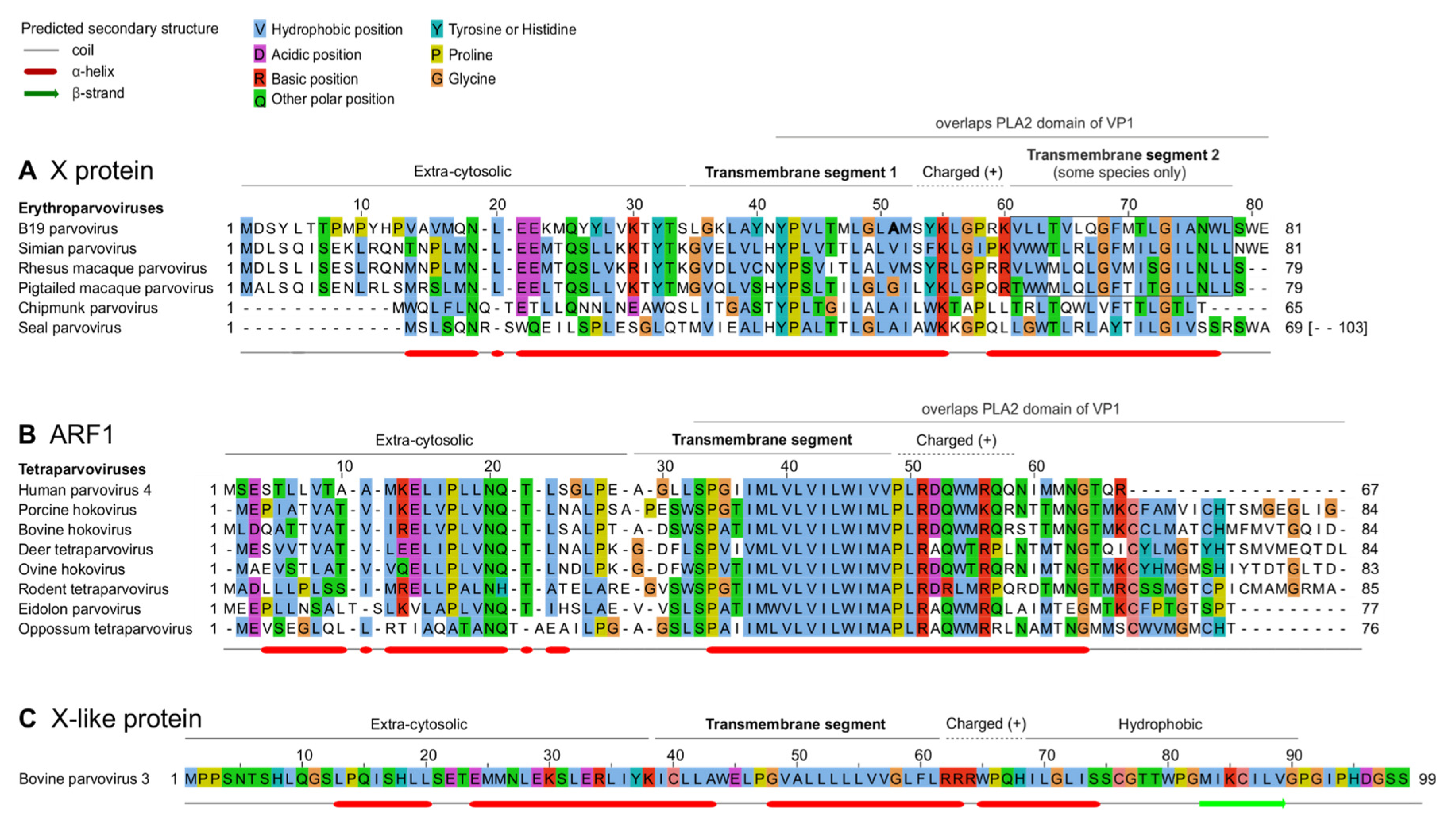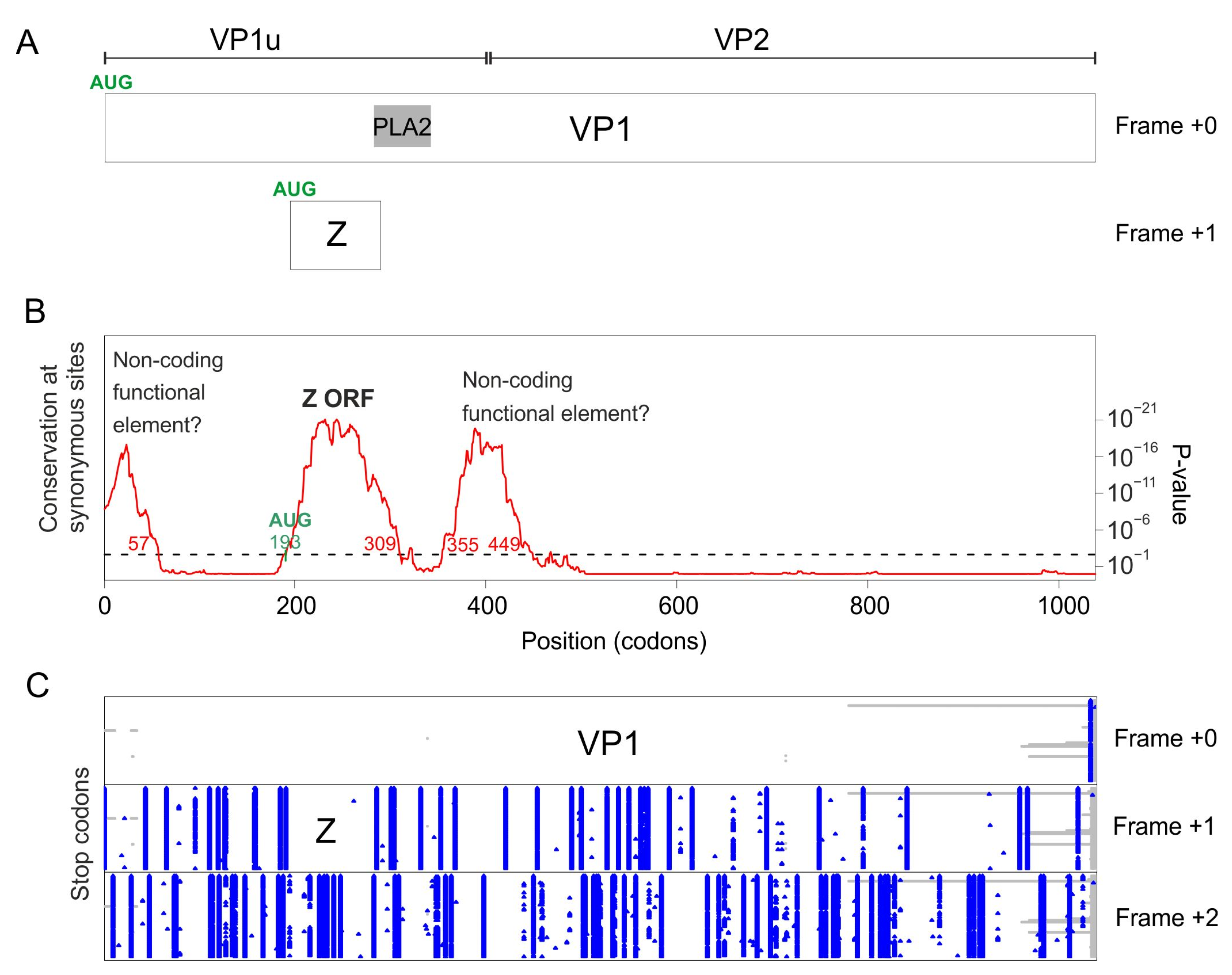Parvovirus B19 and Human Parvovirus 4 Encode Similar Proteins in a Reading Frame Overlapping the VP1 Capsid Gene
Abstract
1. Introduction
2. Materials and Methods
2.1. Sequence Collection
2.2. Nucleotide Sequence Alignment and Analysis
2.3. Detection of Regions with Lower Synonymous Substitution Rate
2.4. Protein Sequence Alignment and Domain Identification
2.5. Prediction of Protein Structural Features
3. Results
3.1. The VP1 Gene of B19V Contains 3 Regions with Significantly Increased Synonymous Conservation, among Which the X ORF

3.2. The VP1 Gene of PARV4 Contains 2 Regions with Significantly Reduced Synonymous Variability, Corresponding to ARF1 and ARF2
3.3. The B19V X Protein and PARV4 ARF1 Protein Have Similar Sequence Features
3.4. Conserved Features of the X and ARF1 Proteins Mostly but Not Exclusively Correspond to Conserved Motifs of the PLA2 Domain of VP1
3.5. The VP1 Gene of Bovine Parvovirus 3 and Porcine Parvovirus 2 Differs from That of Other Erythro- and Tetraparvoviruses
3.5.1. Bovine Parvovirus 3 VP1 Gene Encodes an X-like ORF, despite Not Encoding a PLA2 Domain
3.5.2. Porcine Parvovirus 2 Does Not Encode an X ORF, but Encodes a “Z ORF” Overlapping VP1
4. Discussion
4.1. Sequence Analyses Provide Compelling Evidence That the X Protein Must Be Expressed and Have a Crucial Function
4.2. The X Protein Could Be Translated Either by a Non-Conventional Mechanism or from an Overlooked mRNA
4.2.1. Translation of the X ORF through a Non-Canonical Mechanism
4.2.2. Translation of the X ORF from a Currently Unmapped mRNA
4.3. Are X, ARF1, and the Dependoparvovirus MAAP Protein Likely to Have a Similar Function?
4.4. Neither ARF1 nor the X Protein Are Homologous to the Protoparvovirus SAT Protein
5. Conclusions
Supplementary Materials
Funding
Institutional Review Board Statement
Informed Consent Statement
Data Availability Statement
Acknowledgments
Conflicts of Interest
References
- Söderlund-Venermo, M. Emerging Human Parvoviruses: The Rocky Road to Fame. Annu. Rev. Virol. 2019, 6, 71–91. [Google Scholar] [CrossRef] [PubMed]
- Kailasan, S.; Agbandje-McKenna, M.; Parrish, C.R. Parvovirus Family Conundrum: What Makes a Killer? Annu. Rev. Virol. 2015, 2, 425–450. [Google Scholar] [CrossRef] [PubMed]
- Cotmore, S.F.; Tattersall, P. Parvoviruses: Small Does Not Mean Simple. Annu. Rev. Virol. 2014, 1, 517–537. [Google Scholar] [CrossRef] [PubMed]
- Ganaie, S.S.; Qiu, J. Recent Advances in Replication and Infection of Human Parvovirus B19. Front. Cell. Infect. Microbiol. 2018, 8, 166. [Google Scholar] [CrossRef] [PubMed]
- Matthews, P.C.; Sharp, C.; Simmonds, P.; Klenerman, P. Human parvovirus 4 ‘PARV4’ remains elusive despite a decade of study. F1000Research 2017, 6, 82. [Google Scholar] [CrossRef] [PubMed]
- Luo, W.; Astell, C.R. A Novel Protein Encoded by Small RNAs of Parvovirus B19. Virology 1993, 195, 448–455. [Google Scholar] [CrossRef] [PubMed]
- St Amand, J.; Beard, C.; Humphries, K.; Astell, C.R. Analysis of splice junctions and in vitro and in vivo translation potential of the small, abundant B19 parvovirus RNAs. Virology 1991, 183, 133–142. [Google Scholar] [CrossRef]
- St Amand, J.; Astell, C.R. Identification and characterization of a family of 11-kDa proteins encoded by the human parvovirus B19. Virology 1993, 192, 121–131. [Google Scholar] [CrossRef]
- Zhi, N.; Mills, I.P.; Lu, J.; Wong, S.; Filippone, C.; Brown, K.E. Molecular and functional analyses of a human parvovirus B19 infectious clone demonstrates essential roles for NS1, VP1, and the 11-kilodalton protein in virus replication and infectivity. J. Virol. 2006, 80, 5941–5950. [Google Scholar] [CrossRef]
- Simmonds, P.; Douglas, J.; Bestetti, G.; Longhi, E.; Antinori, S.; Parravicini, C.; Corbellino, M. A third genotype of the human parvovirus PARV4 in sub-Saharan Africa. J. Gen. Virol. 2008, 89, 2299–2302. [Google Scholar] [CrossRef] [PubMed]
- Pavesi, A.; Vianelli, A.; Chirico, N.; Bao, Y.; Blinkova, O.; Belshaw, R.; Firth, A.; Karlin, D. Overlapping genes and the proteins they encode differ significantly in their sequence composition from non-overlapping genes. PLoS ONE 2018, 13, e0202513. [Google Scholar] [CrossRef]
- Pavesi, A. Computational methods for inferring location and genealogy of overlapping genes in virus genomes: Approaches and applications. Curr. Opin. Virol. 2022, 52, 1–8. [Google Scholar] [CrossRef]
- Firth, A.E.; Brown, C.M. Detecting overlapping coding sequences with pairwise alignments. Bioinformatics 2005, 21, 282–292. [Google Scholar] [CrossRef] [PubMed]
- Sabath, N.; Landan, G.; Graur, D. A method for the simultaneous estimation of selection intensities in overlapping genes. PLoS ONE 2008, 3, e3996. [Google Scholar] [CrossRef] [PubMed]
- Norja, P.; Eis-Hübinger, A.M.; Söderlund-Venermo, M.; Hedman, K.; Simmonds, P. Rapid sequence change and geographical spread of human parvovirus B19: Comparison of B19 virus evolution in acute and persistent infections. J. Virol. 2008, 82, 6427–6433. [Google Scholar] [CrossRef][Green Version]
- Firth, A.E. Mapping overlapping functional elements embedded within the protein-coding regions of RNA viruses. Nucleic Acids Res. 2014, 42, 12425–12439. [Google Scholar] [CrossRef]
- Chung, B.Y.-W.; Miller, W.A.; Atkins, J.F.; Firth, A.E. An overlapping essential gene in the Potyviridae. Proc. Natl. Acad. Sci. USA 2008, 105, 5897–5902. [Google Scholar] [CrossRef]
- Jagger, B.W.; Wise, H.M.; Kash, J.C.; Walters, K.-A.; Wills, N.M.; Xiao, Y.-L.; Dunfee, R.L.; Schwartzman, L.M.; Ozinsky, A.; Bell, G.L.; et al. An overlapping protein-coding region in influenza A virus segment 3 modulates the host response. Science 2012, 337, 199–204. [Google Scholar] [CrossRef]
- Ratinier, M.; Caporale, M.; Golder, M.; Franzoni, G.; Allan, K.; Nunes, S.F.; Armezzani, A.; Bayoumy, A.; Rixon, F.; Shaw, A.; et al. Identification and characterization of a novel non-structural protein of bluetongue virus. PLoS Pathog. 2011, 7, e1002477. [Google Scholar] [CrossRef]
- Abascal, F.; Zardoya, R.; Telford, M.J. TranslatorX: Multiple alignment of nucleotide sequences guided by amino acid translations. Nucleic Acids Res. 2010, 38, W7–W13. [Google Scholar] [CrossRef]
- Wang, J.; Gribskov, M. IRESpy: An XGBoost model for prediction of internal ribosome entry sites. BMC Bioinform. 2019, 20, 409. [Google Scholar] [CrossRef] [PubMed]
- McNair, K.; Salamon, P.; Edwards, R.A.; Segall, A.M. PRFect: A tool to predict programmed ribosomal frameshifts in prokaryotic and viral genomes. Res. Sq. 2023. [Google Scholar] [CrossRef]
- Gruber, A.R.; Neubock, R.; Hofacker, I.L.; Washietl, S. The RNAz web server: Prediction of thermodynamically stable and evolutionarily conserved RNA structures. Nucleic Acids Research 2007, 35, W335–W338. [Google Scholar] [CrossRef] [PubMed]
- Washietl, S.; Hofacker, I.L. Identifying Structural Noncoding RNAs Using RNAz. In Current Protocols in Bioinformatics; Baxevanis, A.D., Davison, D.B., Page, R.D.M., Petsko, G.A., Stein, L.D., Stormo, G.D., Eds.; John Wiley & Sons, Inc.: Hoboken, NJ, USA, 2007. [Google Scholar] [CrossRef]
- Waterhouse, A.M.; Procter, J.B.; Martin, D.M.A.; Clamp, M.; Barton, G.J. Jalview Version 2—A multiple sequence alignment editor and analysis workbench. Bioinformatics 2009, 25, 1189–1191. [Google Scholar] [CrossRef]
- Procter, J.B.; Thompson, J.; Letunic, I.; Creevey, C.; Jossinet, F.; Barton, G.J. Visualization of multiple alignments, phylogenies and gene family evolution. Nat. Methods 2010, 7, S16–S25. [Google Scholar] [CrossRef]
- Dereeper, A.; Guignon, V.; Blanc, G.; Audic, S.; Buffet, S.; Chevenet, F.; Dufayard, J.-F.; Guindon, S.; Lefort, V.; Lescot, M.; et al. Phylogeny.fr: Robust phylogenetic analysis for the non-specialist. Nucleic. Acids Res. 2008, 36, W465–W469. [Google Scholar] [CrossRef]
- Castresana, J. Selection of conserved blocks from multiple alignments for their use in phylogenetic analysis. Mol. Biol. Evol. 2000, 17, 540–552. [Google Scholar] [CrossRef]
- Guindon, S.; Gascuel, O. A simple, fast, and accurate algorithm to estimate large phylogenies by maximum likelihood. Syst. Biol. 2003, 52, 696–704. [Google Scholar] [CrossRef]
- Katoh, K.; Frith, M.C. Adding unaligned sequences into an existing alignment using MAFFT and LAST. Bioinformatics 2012, 28, 3144–3146. [Google Scholar] [CrossRef] [PubMed]
- Söding, J.; Biegert, A.; Lupas, A.N. The HHpred interactive server for protein homology detection and structure prediction. Nucleic Acids Res. 2005, 33, W244–W248. [Google Scholar] [CrossRef] [PubMed]
- Zimmermann, L.; Stephens, A.; Nam, S.-Z.; Rau, D.; Kübler, J.; Lozajic, M.; Gabler, F.; Söding, J.; Lupas, A.N.; Alva, V. A Completely Reimplemented MPI Bioinformatics Toolkit with a New HHpred Server at its Core. J. Mol. Biol. 2018, 430, 2237–2243. [Google Scholar] [CrossRef]
- Kozlowski, L.P.; Bujnicki, J.M. MetaDisorder: A meta-server for the prediction of intrinsic disorder in proteins. BMC Bioinform. 2012, 13, 111. [Google Scholar] [CrossRef]
- Ferron, F.; Longhi, S.; Canard, B.; Karlin, D. A practical overview of protein disorder prediction methods. Proteins 2006, 65, 1–14. [Google Scholar] [CrossRef]
- Ludwiczak, J.; Winski, A.; Szczepaniak, K.; Alva, V.; Dunin-Horkawicz, S. DeepCoil-a fast and accurate prediction of coiled-coil domains in protein sequences. Bioinformatics 2019, 35, 2790–2795. [Google Scholar] [CrossRef]
- Kuchibhatla, D.B.; Sherman, W.A.; Chung, B.Y.W.; Cook, S.; Schneider, G.; Eisenhaber, B.; Karlin, D.G. Powerful sequence similarity search methods and in-depth manual analyses can identify remote homologs in many apparently “orphan” viral proteins. J. Virol. 2014, 88, 10–20. [Google Scholar] [CrossRef]
- Dobson, L.; Reményi, I.; Tusnády, G.E. CCTOP: A Consensus Constrained TOPology prediction web server. Nucleic Acids Res 2015, 43, W408–W412. [Google Scholar] [CrossRef]
- Floden, E.W.; Tommaso, P.D.; Chatzou, M.; Magis, C.; Notredame, C.; Chang, J.-M. PSI/TM-Coffee: A web server for fast and accurate multiple sequence alignments of regular and transmembrane proteins using homology extension on reduced databases. Nucleic Acids Res. 2016, 44, W339–W343. [Google Scholar] [CrossRef] [PubMed]
- Zádori, Z.; Szelei, J.; Lacoste, M.C.; Li, Y.; Gariépy, S.; Raymond, P.; Allaire, M.; Nabi, I.R.; Tijssen, P. A viral phospholipase A2 is required for parvovirus infectivity. Dev. Cell 2001, 1, 291–302. [Google Scholar] [CrossRef]
- Dorsch, S.; Liebisch, G.; Kaufmann, B.; von Landenberg, P.; Hoffmann, J.H.; Drobnik, W.; Modrow, S. The VP1 unique region of parvovirus B19 and its constituent phospholipase A2-like activity. J. Virol. 2002, 76, 2014–2018. [Google Scholar] [CrossRef]
- Campbell, M.A.; Loncar, S.; Kotin, R.M.; Gifford, R.J. Comparative analysis reveals the long-term coevolutionary history of parvoviruses and vertebrates. PLoS Biol 2022, 20, e3001867. [Google Scholar] [CrossRef]
- Atkins, J.F.; Loughran, G.; Bhatt, P.R.; Firth, A.E.; Baranov, P.V. Ribosomal frameshifting and transcriptional slippage: From genetic steganography and cryptography to adventitious use. Nucleic Acids Res. 2016, 44, 7007–7078. [Google Scholar] [CrossRef] [PubMed]
- Leisi, R.; Di Tommaso, C.; Kempf, C.; Ros, C. The Receptor-Binding Domain in the VP1u Region of Parvovirus B19. Viruses 2016, 8, 61. [Google Scholar] [CrossRef]
- Baker, J.A.; Wong, W.-C.; Eisenhaber, B.; Warwicker, J.; Eisenhaber, F. Charged residues next to transmembrane regions revisited: “Positive-inside rule” is complemented by the “negative inside depletion/outside enrichment rule. ” BMC Biol. 2017, 15, 66. [Google Scholar] [CrossRef]
- Lo, M.K.; Søgaard, T.M.; Karlin, D.G. Evolution and structural organization of the C proteins of paramyxovirinae. PLoS ONE 2014, 9, e90003. [Google Scholar] [CrossRef]
- Allander, T.; Emerson, S.U.; Engle, R.E.; Purcell, R.H.; Bukh, J. A virus discovery method incorporating DNase treatment and its application to the identification of two bovine parvovirus species. Proc. Natl. Acad. Sci. USA 2001, 98, 11609–11614. [Google Scholar] [CrossRef]
- Wang, F.; Wei, Y.; Zhu, C.; Huang, X.; Xu, Y.; Yu, L.; Yu, X. Novel parvovirus sublineage in the family of Parvoviridae. Virus Genes 2010, 41, 305–308. [Google Scholar] [CrossRef]
- Shade, R.O.; Blundell, M.C.; Cotmore, S.F.; Tattersall, P.; Astell, C.R. Nucleotide sequence and genome organization of human parvovirus B19 isolated from the serum of a child during aplastic crisis. J. Virol. 1986, 58, 921–936. [Google Scholar] [CrossRef]
- Hernández, G.; Osnaya, V.G.; Pérez-Martínez, X. Conservation and Variability of the AUG Initiation Codon Context in Eukaryotes. Trends Biochem. Sci. 2019, 44, 1009–1021. [Google Scholar] [CrossRef]
- Firth, A.E.; Brierley, I. Non-canonical translation in RNA viruses. J. Gen. Virol. 2012, 93, 1385–1409. [Google Scholar] [CrossRef] [PubMed]
- Gupta, A.; Bansal, M. RNA-mediated translation regulation in viral genomes: Computational advances in the recognition of sequences and structures. Brief. Bioinform. 2019, 21, 1151–1163. [Google Scholar] [CrossRef] [PubMed]
- Ozawa, K.; Ayub, J.; Young, N. Translational regulation of B19 parvovirus capsid protein production by multiple upstream AUG triplets. J. Biol. Chem. 1988, 263, 10922–10926. [Google Scholar] [CrossRef]
- Baralle, M.; Baralle, F.E. The splicing code. Biosystems 2018, 164, 39–48. [Google Scholar] [CrossRef] [PubMed]
- Karlin, D.G. Sequence Properties of the MAAP Protein and of the VP1 Capsid Protein of Adeno-Associated Viruses. Life Sci. 2020. [Google Scholar] [CrossRef]
- Ogden, P.J.; Kelsic, E.D.; Sinai, S.; Church, G.M. Comprehensive AAV capsid fitness landscape reveals a viral gene and enables machine-guided design. Science 2019, 366, 1139–1143. [Google Scholar] [CrossRef] [PubMed]
- Zádori, Z.; Szelei, J.; Tijssen, P. SAT: A late NS protein of porcine parvovirus. J. Virol. 2005, 79, 13129–13138. [Google Scholar] [CrossRef]
- Sealfon, R.S.; Lin, M.F.; Jungreis, I.; Wolf, M.Y.; Kellis, M.; Sabeti, P.C. FRESCo: Finding regions of excess synonymous constraint in diverse viruses. Genome Biol. 2015, 16, 38. [Google Scholar] [CrossRef]








| Genus | Species | Common Name(s) [Abbreviation] | Genbank Genome Accession Number | Boundaries of the X ORF in the Genome Sequence (in Nucleotides) |
|---|---|---|---|---|
| Erythroparvovirus | Primate erythroparvovirus 1 | Parvovirus B19 [B19V] | NC_000883 | 2874–3119 |
| Erythroparvovirus | Primate erythroparvovirus 2 | Simian parvovirus | U26342.1 | 2718–2963 |
| Erythroparvovirus | Primate erythroparvovirus 3 | Rhesus macaque parvovirus | AF221122.1 | 2841–3080 |
| Erythroparvovirus | Primate erythroparvovirus 4 | Pig-tailed macaque parvovirus | AF221123.1 | 2563–2802 |
| Erythroparvovirus | Rodent erythroparvovirus 1 | Chipmunk parvovirus | GQ200736.1 | 3031–3228 |
| Erythroparvovirus | Pinniped erythroparvovirus 1 | Seal parvovirus | KF373759.1 | 2789–3100 |
| Erythroparvovirus (*) | Ungulate erythroparvovirus 1 | Bovine parvovirus 3 [bPARV3] | NC_037053 | 2627–2926 |
| Tetraparvovirus | Chiropteran tetraparvovirus 1 | Eidolon helvum parvovirus | NC_016744.1 | 2829–3062 |
| Tetraparvovirus | Primate tetraparvovirus 1 | Human parvovirus 4 [PARV4] | NC_007018.1 | 2937–3140 |
| Tetraparvovirus | Ungulate tetraparvovirus 1 | Bovine hokovirus 1 | NC_028136 | 2857–3111 |
| Tetraparvovirus | Ungulate tetraparvovirus 2 | Porcine hokovirus | EU200677.1 | 2808–3062 |
| Tetraparvovirus | Ungulate tetraparvovirus 5 | Deer tetraparvovirus | NC_031670.1 | 2766–3020 |
| Tetraparvovirus (*) | Ungulate tetraparvovirus 3 | Porcine parvovirus 2 [pPARV2]; Porcine cnvirus; Parvovirus YX | NC_035180 | No X ORF; boundaries of the Z ORF are 2817–3098 |
| Tetraparvovirus | Ungulate tetraparvovirus 4 | Ovine hokovirus | JF504699.1 | 2855–3112 |
| Tetraparvovirus | - | Opossum parvovirus | MG745671.1 | 2862–3092 |
| Tetraparvovirus | - | Rodent parvovirus | MG745669.1 | 2960–3217 |
| Virus Name | Region | Boundaries of the Region with Lower Synonymous Codon Variability in the VP1 CDS | Boundaries of the Corresponding ORF in the VP1 CDS |
|---|---|---|---|
| Parvovirus B19 | X ORF | Codons 58–163 (nucleotides 172–489) | Codons 84–166 (Nucleotides 251–496) |
| Parvovirus B19 | Y region (*) | Codons 185–239 (nucleotides 553–715) | Codons 185–230 (*) (nucleotides 553–688) |
| Human parvovirus 4 | ARF1 ORF (=X ORF) | Codons 180–263 (nucleotides 538–789) | Codons 187–255 (nucleotides 560–763) |
| Human parvovirus 4 | ARF2 ORF | Codons 294–397 (nucleotides 880–1189) | Codons 295–379 (nucleotides 884–1135) |
| Bovine parvovirus 3 | X-like ORF | Codons 205–306 (nucleotides 614–916) | Codons 215–315 (nucleotides 644–943) |
| Porcine parvovirus 2 | Z ORF | Codons 193–309 (nucleotides 577–927) | Codons 193–285 (nucleotides 578–854) |
Disclaimer/Publisher’s Note: The statements, opinions and data contained in all publications are solely those of the individual author(s) and contributor(s) and not of MDPI and/or the editor(s). MDPI and/or the editor(s) disclaim responsibility for any injury to people or property resulting from any ideas, methods, instructions or products referred to in the content. |
© 2024 by the author. Licensee MDPI, Basel, Switzerland. This article is an open access article distributed under the terms and conditions of the Creative Commons Attribution (CC BY) license (https://creativecommons.org/licenses/by/4.0/).
Share and Cite
Karlin, D.G. Parvovirus B19 and Human Parvovirus 4 Encode Similar Proteins in a Reading Frame Overlapping the VP1 Capsid Gene. Viruses 2024, 16, 191. https://doi.org/10.3390/v16020191
Karlin DG. Parvovirus B19 and Human Parvovirus 4 Encode Similar Proteins in a Reading Frame Overlapping the VP1 Capsid Gene. Viruses. 2024; 16(2):191. https://doi.org/10.3390/v16020191
Chicago/Turabian StyleKarlin, David G. 2024. "Parvovirus B19 and Human Parvovirus 4 Encode Similar Proteins in a Reading Frame Overlapping the VP1 Capsid Gene" Viruses 16, no. 2: 191. https://doi.org/10.3390/v16020191
APA StyleKarlin, D. G. (2024). Parvovirus B19 and Human Parvovirus 4 Encode Similar Proteins in a Reading Frame Overlapping the VP1 Capsid Gene. Viruses, 16(2), 191. https://doi.org/10.3390/v16020191





